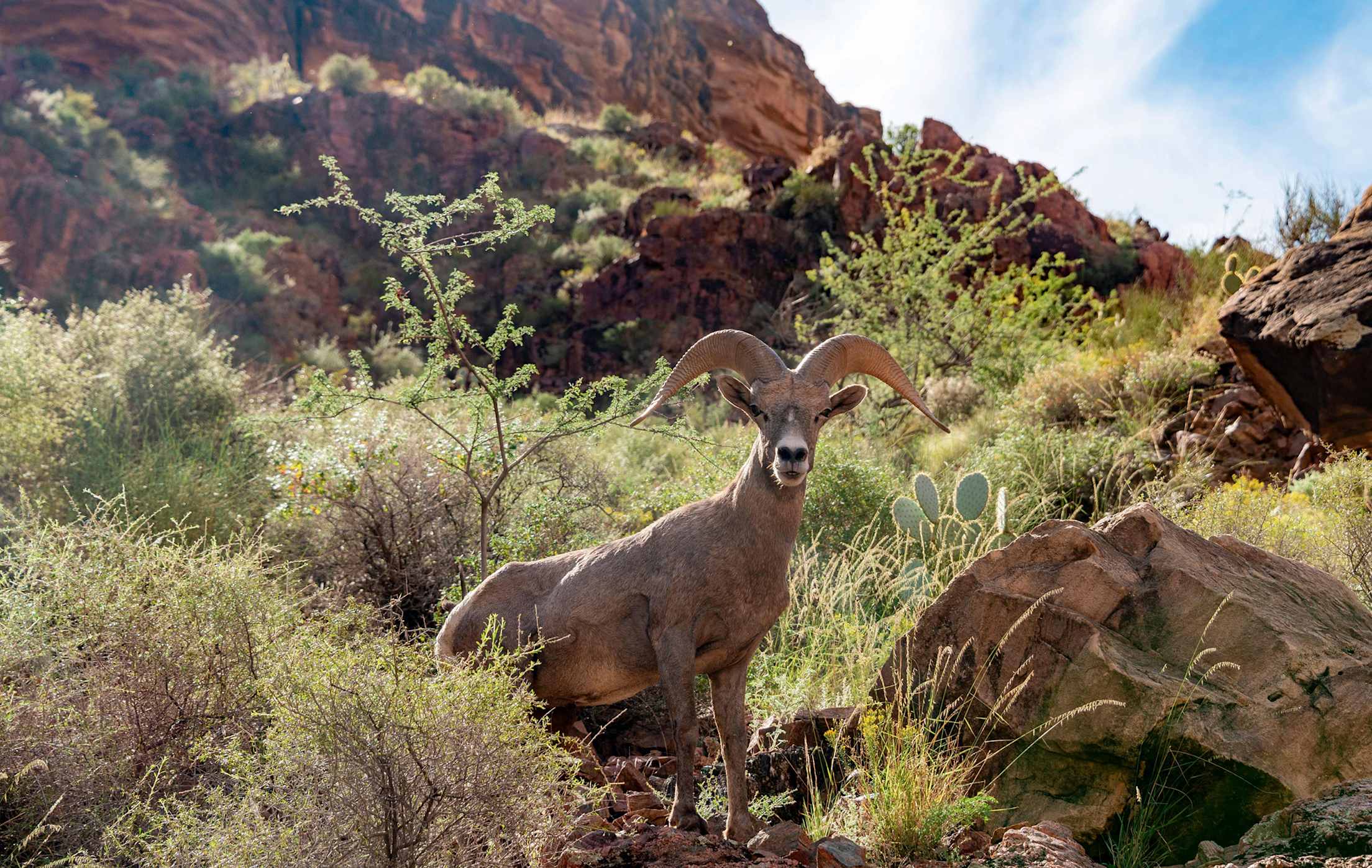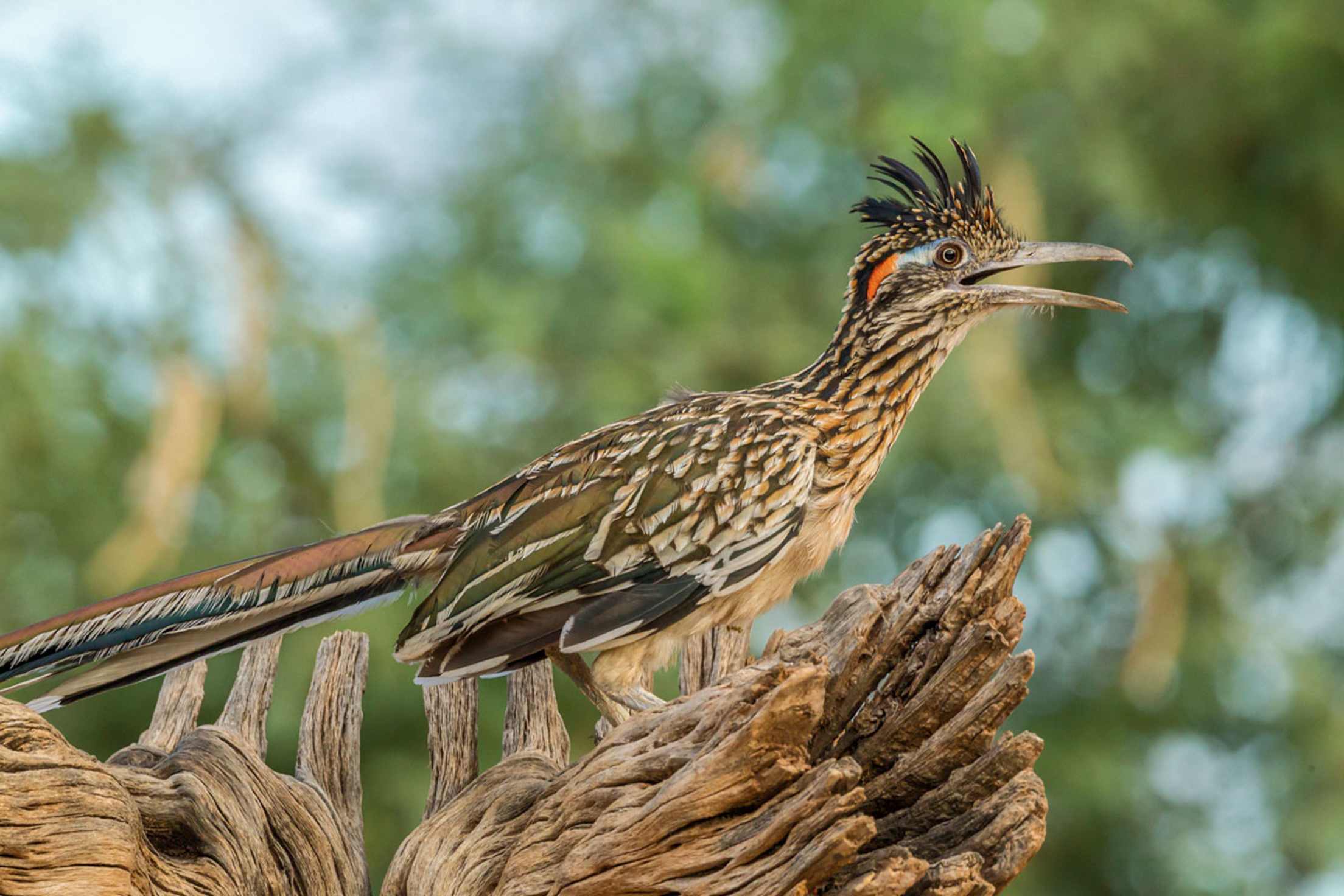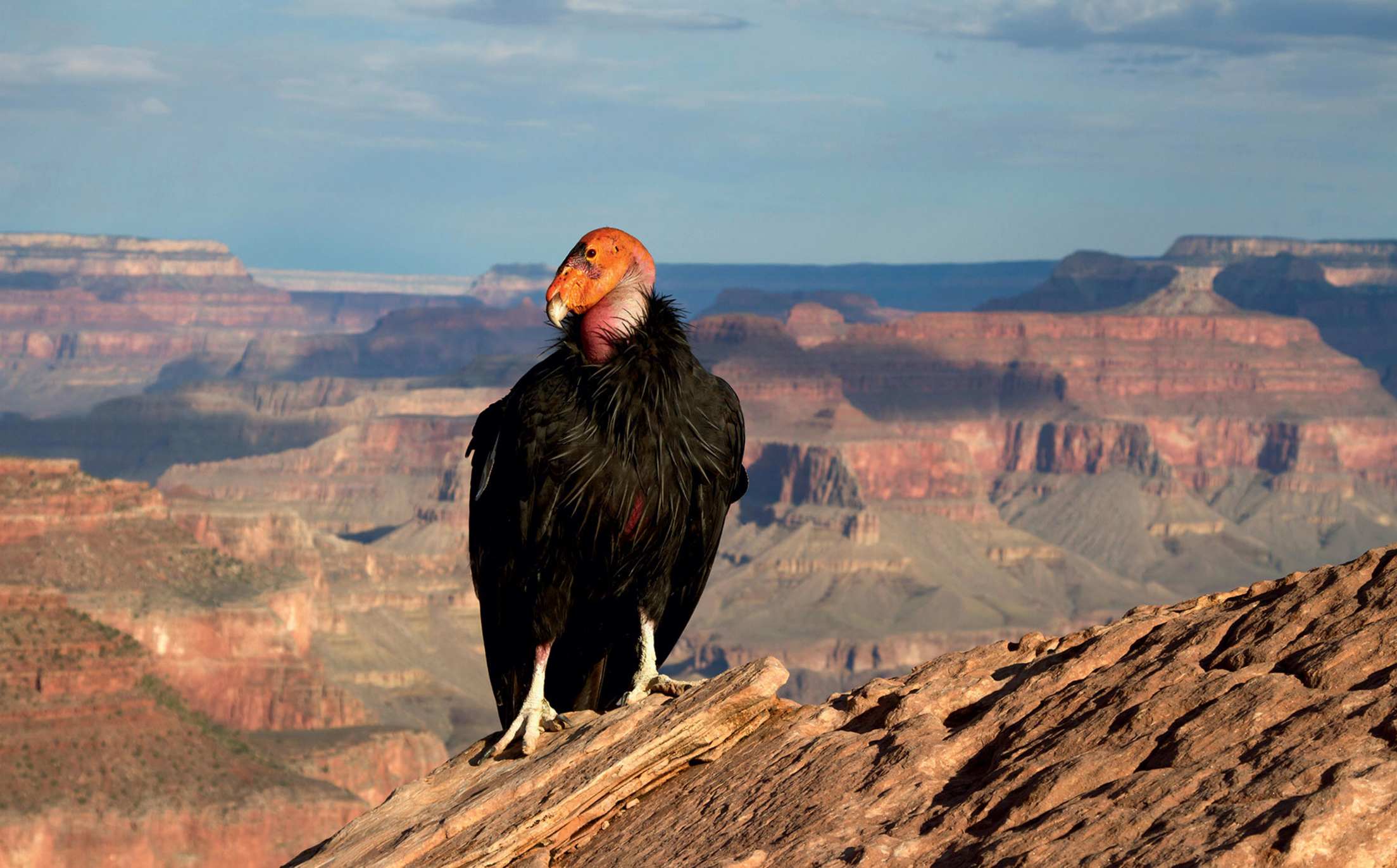
Where to See Arizona's Wondrous Wildlife
Public parks and accredited zoos offer glimpses of the state's remarkable animals.

Home to the most biodiverse desert on earth, Arizona is rife with wildlife. Striving to spot its scaly, feathery, and furry creatures in action can provide hours of engaging activity for nature-loving humans who want to spend some quality time outside.
The spectacle begins each January in the southeastern wetlands, where 30,000 migrating sandhill cranes trill and trumpet in a sort of avian chorale. In March, rosy boas, blue-and-yellow Sonoran whipsnakes, and other reptiles start to slither out of their winter slumber to shimmy among the wildflowers in the desert near Phoenix. Between April and May, millions of songbirds—trogons, flycatchers, warblers—splash color on the riparian oases that ribbon the state. When summer starts to swelter, scorpions emerge at dusk to prey on crickets, beetles, and spiders. During monsoon season, July through September, hummingbirds flutter around flowering shrubs and poke at man-made feeders, flashing their emerald, ruby, and violet feathers. Come fall, elk bugle to attract mates in the eastern White Mountains.
Beyond these seasonal highlights, nature puts on quite a show here year-round. Some of the state's most emblematic animals are perennially active, making sightings possible whenever you're out for a hike, paddle, picnic, or drive. The best times to catch glimpses of native critters are at dawn and dusk. For greatest success, wear neutral colors, avoid strongly scented toiletries, and bring binoculars for close-ups. Or visit an accredited zoo, such as the Arizona-Sonora Desert Museum in Tucson.
Here's a guide to six Arizona icons—western diamondback rattlesnakes, desert bighorn sheep, javelinas, coyotes, roadrunners, and condors—along with tips for observing them safely.
Wildlife Safety Tips
The Arizona Game and Fish Department recommends the following:
- Watch from a distance. Never pursue, touch, feed, or throw things at wild animals. Human interaction is extremely stressful for most species, and creatures can become dangerous when they feel threatened.
- Leave your dog at home. Your four-legged friend's natural behaviors, including barking, may startle wild animals and prompt an attack.
- When you spot a wild animal, stop moving and be quiet. Don't stare at its face; eye contact is often perceived as a threat. One exception: If you encounter a mountain lion, make eye contact and try to seem as large and threatening as possible. Stand and wave your arms, speak loudly, and open your jacket. Pick up or hold on to children while maintaining eye contact with the lion.

Western Diamondback Rattlesnakes
At up to six feet long, the western diamondback is the largest rattlesnake in Arizona. It's also the most famous, thanks to the state's Major League Baseball team. Yet you may have trouble spotting one in the wild. Its primary defensive behavior is to hide, blending into the desert with its lozenge-patterned, pink and granite-colored skin. On rare occasions, it warns intruders by rattling: The snake holds up its tail, which consists of hollow, empty segments of keratin—the same protein that's in your fingernails—and shakes it back and forth more than 90 times per second, causing the segments to clatter together like maracas.
When Erika Nowak first started radio tracking western diamondbacks, people warned her that rattlers were aggressive and dangerous. "Within two weeks, I found that pretty much everything I'd heard about their behavior was false," says Nowak, an assistant research professor at Northern Arizona University's School of Earth and Sustainability. "Rattlesnakes are not aggressive. They're actually really shy."
Hikers might happen upon a diamondback between March and October on trails at lower elevations around the state. The Boyce Thompson Arboretum in Superior reports frequent sightings. All rattlesnakes are venomous and some are potentially deadly, so it's essential to keep your distance. If you see or hear one, leave it alone and stay at least 10 feet away, Nowak advises.
The safest way to observe a western diamondback is in captivity. The Phoenix Zoo typically exhibits all 13 species of rattlesnake native to Arizona. You can also watch an online presentation by the Arizona-Sonora Desert Museum's savvy professional handlers, or tour the Phoenix Herpetological Sanctuary, which also offers courses to area residents on how to relocate stray rattlers.

Desert Bighorn Sheep
Few sights are more majestic than a desert bighorn standing sentinel on a ridge above the Colorado River, except perhaps its descent. The sheep's cloven hooves act as natural crampons, gripping the rocks as it clambers down steep cliffs with poise. The gravity-defying feat is even more impressive when you consider that a ram's head can be freakishly heavy, with curved horns weighing up to 30 pounds—more than the rest of its skeleton combined.
When males fight for dominance, primarily during the fall breeding season, they rear up on their hind legs, charge on all fours, and crash their heads together with a mighty clack. The force can be 10 times greater than that of two football players colliding, yet the sheep don't sustain concussions. Their thick skulls and the extra blood in their brains create a protective "bubble wrap effect." Inspired by the sheep's physiology, scientists developed an athletic collar that has shown promising results in preventing traumatic brain injuries among football and hockey players.
Humans, however, haven't been as beneficial to desert bighorns. After European settlers arrived in the 1500s, sheep populations plummeted due to hunting and disease. They were reintroduced in many areas four centuries later.
Today, the state's largest indigenous flock persists in Grand Canyon National Park. In western Arizona, you can also behold bighorns in Kofa National Wildlife Refuge near Yuma, in River Island State Park and Bill Williams River National Wildlife Refuge near Lake Havasu City, and along the Colorado River south of Hoover Dam. (Kayaking trips are offered by Desert Adventures.) In the past few years, sheep have also been re-released in the Santa Catalina Mountains and the Aravaipa Canyon north of Tucson.

Javelinas
The late nature writer Edward Abbey once described the bristly-haired, hoglike javelina as "whimsical, cockeyed, half-mad, always eccentric, more or less lovable." The animal's rough-and-tumble charm gained widespread attention in February 2020, when video of a rogue beast sprinting past a gated community in Tucson went viral online. More than 7 million viewers couldn't resist watching the javelina run up to 35 mph on its stubby legs.
Officially called collared peccaries, they're known as javelinas because of their javelin-like canine teeth. They're also nicknamed musk hogs for the smelly substance they excrete from their rump glands and rub over one another as a distinctive communal cologne. Squadrons of them frequently roam Arizona's neighborhoods, feasting on garden plants and garbage, lounging on lawns, and lapping up pool water.
Whether you see them as a nuisance or a delight simply depends on your perspective. In the central oasis of Page Springs, vintners Rod and Cynthia Snapp and Lucas Reed so enjoy seeing mature javelinas and their "cute little ones" snuffling around their vineyard, noshing on cacti and tubers, that they named the winery Javelina Leap.
You can observe javelinas in captivity at the Arizona-Sonora Desert Museum. Or you can try your luck at spotting them in the wild at Saguaro National Park or various state parks, including Lost Dutchman near Apache Junction, Catalina near Tucson, Patagonia Lake near Patagonia, Dead Horse Ranch near Cottonwood, and Red Rock and Slide Rock in Sedona.

Coyotes
For many people, including the Navajo, the coyote embodies a powerful spirit that's equal parts trickster and teacher. The canines' vocalizations, which can be frequently heard by hikers in mountain preserves, create the eerily wonderful chorus that gives coyotes the nickname "song dogs." It's also why fans of Arizona's National Hockey League team, the Coyotes, voted to name its mascot Howler.
Native to the West, coyotes descended from an ancestor of wolves and dogs, splitting off as their own species about 1 million years ago. In fact, the animal's typical features—pointy ears, brown or gray coat with a white belly, and bushy tail—lead some people to mistake coyotes for stray pets.
"About 95 percent of all of the behaviors that we know from domestic dogs occur in coyotes, [including] expressions of emotion, love, and caring [for] each other," explains Paul Paquet, a biologist with the conservation nonprofit Project Coyote.
Yet the smart wild canines are often unfairly maligned as a nuisance or a threat. European settlers slaughtered them by the millions over the past two centuries, and people still kill some 500,000 coyotes in the U.S. each year.
Coyotes mainly feast on small critters and plants, and their adaptability allows them to thrive in both urban and rural settings. You can occasionally see them loping across municipal and state parks. Possible locations for sightings include South Mountain Park in Phoenix, Catalina in Tucson, Lost Dutchman near Apache Junction, Red Rock in Sedona, and River Island near Lake Havasu City.

Roadrunners
The cactus wren may be the official state bird, but the charismatic roadrunner commands more attention. The Arizona-Sonora Desert Museum calls the roadrunner "the most famous bird in the Sonoran Desert," thanks to all the Looney Tunes cartoons emphasizing its speed. It's no coincidence that when the Arizona Coyotes acquired a minor-league team, fans dubbed it the Tucson Roadrunners.
As their name suggests, roadrunners rarely use their wings to travel. Instead they run, regularly at about 15 mph—but they can hit speeds up to 26 mph, just a few beaks behind world record–holding sprinter Usain Bolt on his best day. In fact, the roadrunner is the world's fastest-running bird capable of flight.
Roadrunners are also known for their spiky black mohawks, striking size (about two feet long, from bill to tail tip), and spunky predatory behaviors. They occasionally eat small rattlesnakes after pecking them to death, and they often dine on centipedes, rodents, scorpions, or tarantulas after bashing them against a rock. The birds also jump in the air to devour insects and even hummingbirds.
You can often spot roadrunners dashing across public parks statewide, as well as through the Desert Botanical Garden in Phoenix and the Arizona-Sonora Desert Museum in Tucson. If you're in Tucson, don't miss the mural at Fourth Street and Stone Avenue that pays homage to roadrunners, horned toads, rattlesnakes, and the strong local cycling community.

Condors
The so-called California condor first arrived in the Grand Canyon more than 43,000 years ago. During the Pleistocene epoch, the vulture species circled the skies above the West, scavenging the remains of mammoths, giant ground sloths, and other megafauna.
Scientists don't know whether these birds resided here continuously until modern times, but they do know that they were nearly extinct by 1924. One of the biggest threats: lead poisoning from eating carrion contaminated by bullets. A vigorous conservation and reintroduction program has swelled the bird's ranks in recent years. Although the species is still endangered, 92 condors are known to inhabit northern Arizona's canyon country.
Condors are unmistakable in appearance, with pink, vulturelike heads atop massive bodies—18 to 31 pounds—and 9-to-10-foot wingspans. You can gaze at them gliding above the Grand Canyon; rangers at the South Rim often give expert condor talks, in which you learn that the birds live up to 60 years and poop on their legs to keep cool. Or you can witness young birds bred in captivity being released into the wild at Vermilion Cliffs National Monument, also in northern Arizona.

Seasonal Encounters
Bald eagles. Although most of the access points to nesting areas in central Arizona are closed during breeding season (December to May), the Verde Canyon Railroad still rumbles by. Hop aboard one of its open-air viewing cars for a chance to see the emblematic bird, or attend a demonstration at the train depot.
Sandhill cranes. The best time to marvel at the huge flocks of sandhill cranes, which migrate by the tens of thousands to southeastern Arizona each year, is during the Wings Over Willcox festival. The 2021 event is slated to happen Jan. 13–16.
Horses. Wild colts, mares, and stallions—descendants of the equines brought to the continent by Spanish colonists—frequent the areas along the Lower Salt River year-round, but June brings peak water flow. You can rent a kayak from Saguaro Lake Guest Ranch near Mesa to paddle past them. Landlubbers can look for horses at Phon D Sutton Recreation Site and at Coon Bluff.
Hummingbirds. On select dates between April and September, you can watch Southeastern Arizona Bird Observatory staffers capture, band, and release hummingbirds as part of a long-term study of migration patterns.
Bison. Grand Canyon Conservancy offers service-based trips most summers, when you can work alongside researchers to assess the environmental impact of the bison herd that roams the meadows and forests of the canyon's North Rim.